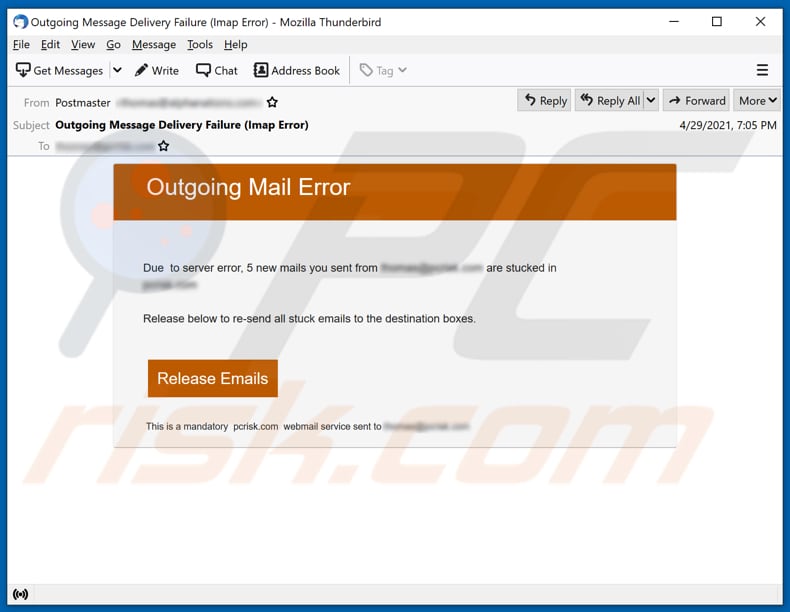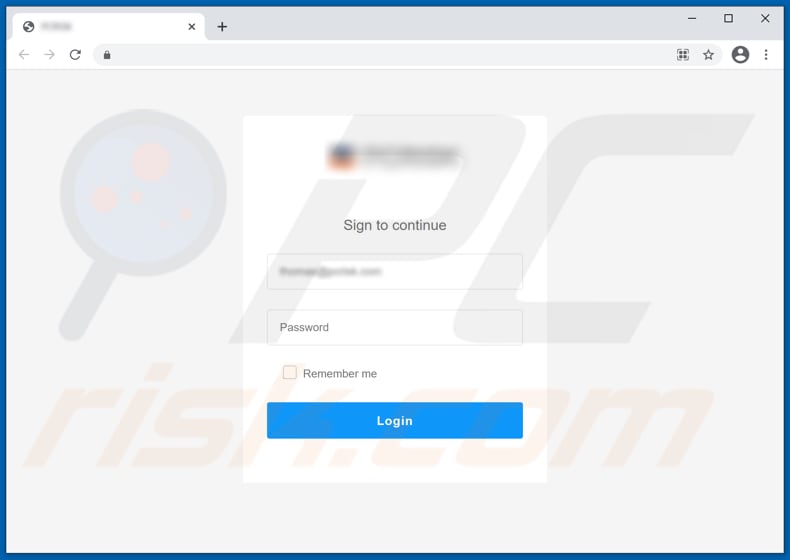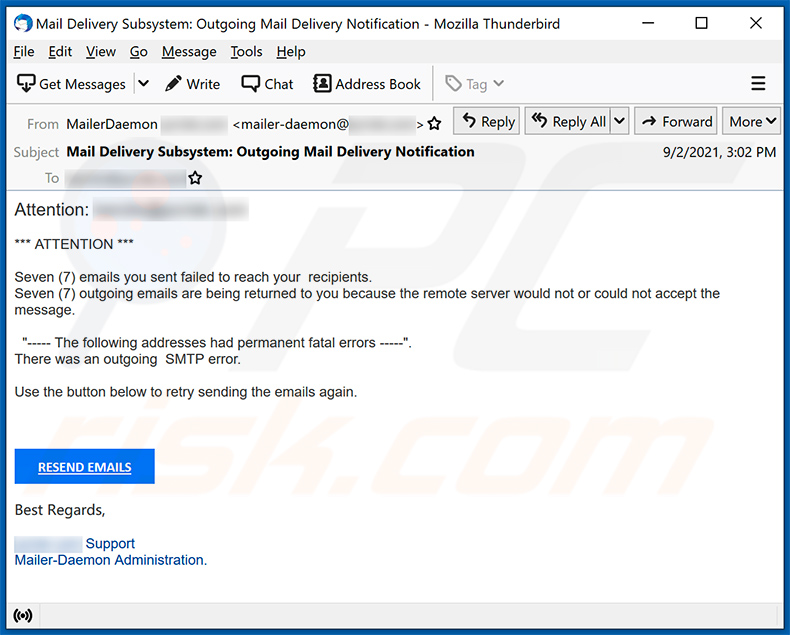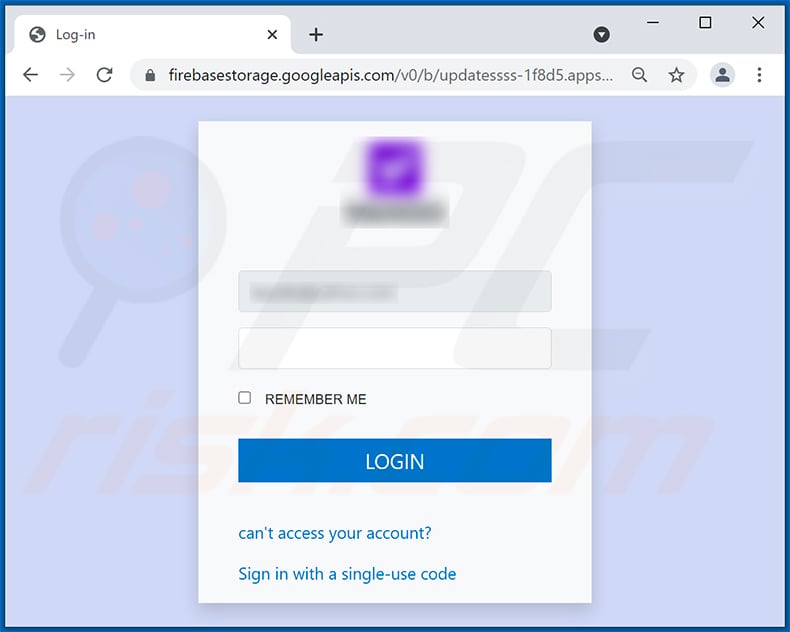Get free scan and check if your device is infected.
Remove it nowTo use full-featured product, you have to purchase a license for Combo Cleaner. Seven days free trial available. Combo Cleaner is owned and operated by RCS LT, the parent company of PCRisk.com.
What is Outgoing Mail Error scam?
It is popular among cybercriminals to use email as a tool to trick users into extracting personal information. Email using deception to obtain sensitive details is called a phishing email.
As a rule, it contains a website link leading to a deceptive website asking to provide login credentials (e.g., usernames, email addresses, passwords), credit card details, or other sensitive information.
It is important to mention that to trick recipients into providing information, cybercriminals pretend to be legitimate companies, organizations, or other entities. This phishing email is disguised as a notification from the email service provider.

"Outgoing Mail Error" email scam overview
Cybercriminals behind this phishing email attempt to trick recipients into believing that there is a problem with their email account. They claim that five messages got "stuck" due to a server error and encourage recipients to resend those emails by logging into their email account via the provided website.
That deceptive website asks to enter an email address and password (email account login credentials). It is clear that cybercriminals behind this email seek to steal login credentials for email accounts.
Usually, cybercriminals check hijacked accounts for messages containing personal information, or they use them to spread spam or malspam (emails with malicious attachments, links), trick other users into transferring them money, or providing personal information.
It is also common that cybercriminals monetize stolen accounts/login credentials by selling them to third parties (other cybercriminals) on the darkweb or through other channels. One more important detail about stolen login credentials is that cybercriminals could use them to access other accounts. It works when users use the same login credentials for more than one account.
| Name | Outgoing Mail Error Scam |
| Threat Type | Phishing, Scam, Social Engineering, Fraud |
| Fake Claim | Emails cannot be sent due to server error |
| Disguise | Notification from the email service provider |
| Symptoms | Unauthorized online purchases, changed online account passwords, identity theft, illegal access of the computer. |
| Distribution methods | Deceptive emails, rogue online pop-up ads, search engine poisoning techniques, misspelled domains. |
| Damage | Loss of sensitive private information, monetary loss, identity theft. |
| Malware Removal (Windows) |
To eliminate possible malware infections, scan your computer with legitimate antivirus software. Our security researchers recommend using Combo Cleaner. Download Combo CleanerTo use full-featured product, you have to purchase a license for Combo Cleaner. 7 days free trial available. Combo Cleaner is owned and operated by RCS LT, the parent company of PCRisk.com. |
Similar scams in general
As mentioned in the first paragraph, it is common among cybercriminals to use phishing emails (and websites) to obtain personal information. A couple of examples of other emails of this type are "Verify Your Email Account Scam", "Secure Your Email Scam", and "LinkedIn Email Scam".
As mentioned in the first paragraph, most cybercriminals disguise their emails as important, official letters from legitimate companies. It is important to know that emails can be used not only to extract personal information but also to distribute malicious software. "Walmart Email Virus" and "SALAMA Email Virus" are two examples of malspam campaigns.
How do spam campaigns infect computers?
Cybercriminals use emails to trick recipients into infecting their computers by sending download pages for malicious files or malicious attachments. Usually, those files (or attachments) are Microsoft Office documents, JavaScript files, executable files (like EXE), archive files (like ZIP, RAR), PDF documents.
In most cases, those files install malicious software after opening or unarchiving and opening them. It is important to mention that malicious documents opened with MS Office 2010 or newer do not install malware until users enable macros commands (editing/content).
Malicious documents opened with older versions infect malware without asking any permission because the aforementioned MS Office versions do not have the "Protected View" mode that prevents malicious documents from installing malware right after they are opened.
How to avoid installation of malware?
It is advisable not to use Peer-to-Peer networks (like torrent clients, eMule), unofficial web pages, third-party downloaders (and installers), and so on as tools to download or install any programs or files. Software, files should come from official websites and via direct links.
Another important thing is to update and activate installed software using implemented functions (or tools) that its official developers have created. Third-party, unofficial tools often are designed to infect computers with malware.
Besides, it is not legal to activate software with unofficial ('cracking') tools. Furthermore, website links and attachments in irrelevant emails should not be opened, especially when they are included in emails sent from unknown, suspicious addresses.
It is common that emails of this kind are used to trick recipients into infecting installing malicious software. Additionally, a computer should be scanned for viruses regularly, and it should be done using a reputable antivirus or anti-spyware software.
If you've already opened malicious attachments, we recommend running a scan with Combo Cleaner Antivirus for Windows to automatically eliminate infiltrated malware.
Text presented in the Outgoing Mail Error phishing email:
Subject: Outgoing Message Delivery Failure (Imap Error)
Outgoing Mail Error
Due to server error, 5 new mails you sent from ******** are stucked in ********
Release below to re-send all stuck emails to the destination boxes.
Release Emails
This is a mandatory ******** webmail service sent to ********
Screenshot of the phishing website used to steal login credentials:

Another example of outgoing mail-themed spam promoting a phishing site:

Text presented within:
Subject: Mail Delivery Subsystem: Outgoing Mail Delivery Notification
Attention: ********
*** ATTENTION ***
Seven (7) emails you sent failed to reach your recipients.
Seven (7) outgoing emails are being returned to you because the remote server would not or could not accept the message.
"----- The following addresses had permanent fatal errors -----".
There was an outgoing SMTP error.Use the button below to retry sending the emails again.
RESEND EMAILS
Best Regards,
******** Support
Mailer-Daemon Administration.
Screenshot of the promoted phishing site:

Instant automatic malware removal:
Manual threat removal might be a lengthy and complicated process that requires advanced IT skills. Combo Cleaner is a professional automatic malware removal tool that is recommended to get rid of malware. Download it by clicking the button below:
DOWNLOAD Combo CleanerBy downloading any software listed on this website you agree to our Privacy Policy and Terms of Use. To use full-featured product, you have to purchase a license for Combo Cleaner. 7 days free trial available. Combo Cleaner is owned and operated by RCS LT, the parent company of PCRisk.com.
Quick menu:
- What is Outgoing Mail spam?
- Types of malicious emails.
- How to spot a malicious email?
- What to do if you fell for an email scam?
Types of malicious emails:
![]() Phishing Emails
Phishing Emails
Most commonly, cybercriminals use deceptive emails to trick Internet users into giving away their sensitive private information, for example, login information for various online services, email accounts, or online banking information.
Such attacks are called phishing. In a phishing attack, cybercriminals usually send an email message with some popular service logo (for example, Microsoft, DHL, Amazon, Netflix), create urgency (wrong shipping address, expired password, etc.), and place a link which they hope their potential victims will click on.
After clicking the link presented in such email message, victims are redirected to a fake website that looks identical or extremely similar to the original one. Victims are then asked to enter their password, credit card details, or some other information that gets stolen by cybercriminals.
![]() Emails with Malicious Attachments
Emails with Malicious Attachments
Another popular attack vector is email spam with malicious attachments that infect users' computers with malware. Malicious attachments usually carry trojans that are capable of stealing passwords, banking information, and other sensitive information.
In such attacks, cybercriminals' main goal is to trick their potential victims into opening an infected email attachment. To achieve this goal, email messages usually talk about recently received invoices, faxes, or voice messages.
If a potential victim falls for the lure and opens the attachment, their computers get infected, and cybercriminals can collect a lot of sensitive information.
While it's a more complicated method to steal personal information (spam filters and antivirus programs usually detect such attempts), if successful, cybercriminals can get a much wider array of data and can collect information for a long period of time.
![]() Sextortion Emails
Sextortion Emails
This is a type of phishing. In this case, users receive an email claiming that a cybercriminal could access the webcam of the potential victim and has a video recording of one's masturbation.
To get rid of the video, victims are asked to pay a ransom (usually using Bitcoin or another cryptocurrency). Nevertheless, all of these claims are false - users who receive such emails should ignore and delete them.
How to spot a malicious email?
While cyber criminals try to make their lure emails look trustworthy, here are some things that you should look for when trying to spot a phishing email:
- Check the sender's ("from") email address: Hover your mouse over the "from" address and check if it's legitimate. For example, if you received an email from Microsoft, be sure to check if the email address is @microsoft.com and not something suspicious like @m1crosoft.com, @microsfot.com, @account-security-noreply.com, etc.
- Check for generic greetings: If the greeting in the email is "Dear user", "Dear @youremail.com", "Dear valued customer", this should raise suspiciousness. Most commonly, companies call you by your name. Lack of this information could signal a phishing attempt.
- Check the links in the email: Hover your mouse over the link presented in the email, if the link that appears seems suspicious, don't click it. For example, if you received an email from Microsoft and the link in the email shows that it will go to firebasestorage.googleapis.com/v0... you shouldn't trust it. It's best not to click any links in the emails but to visit the company website that sent you the email in the first place.
- Don't blindly trust email attachments: Most commonly, legitimate companies will ask you to log in to their website and to view any documents there; if you received an email with an attachment, it's a good idea to scan it with an antivirus application. Infected email attachments are a common attack vector used by cybercriminals.
To minimise the risk of opening phishing and malicious emails we recommend using Combo Cleaner Antivirus for Windows.
Example of a spam email:

What to do if you fell for an email scam?
- If you clicked on a link in a phishing email and entered your password - be sure to change your password as soon as possible. Usually, cybercriminals collect stolen credentials and then sell them to other groups that use them for malicious purposes. If you change your password in a timely manner, there's a chance that criminals won't have enough time to do any damage.
- If you entered your credit card information - contact your bank as soon as possible and explain the situation. There's a good chance that you will need to cancel your compromised credit card and get a new one.
- If you see any signs of identity theft - you should immediately contact the Federal Trade Commission. This institution will collect information about your situation and create a personal recovery plan.
- If you opened a malicious attachment - your computer is probably infected, you should scan it with a reputable antivirus application. For this purpose, we recommend using Combo Cleaner Antivirus for Windows.
- Help other Internet users - report phishing emails to Anti-Phishing Working Group, FBI’s Internet Crime Complaint Center, National Fraud Information Center and U.S. Department of Justice.
Frequently Asked Questions (FAQ)
Why did I receive this email?
Scammers send identical, generic emails to thousands of people to trick as many victims as possible. Thus, you received this email only because scammers have obtained your email address from somewhere.
I have provided my personal information when tricked by this email, what should I do?
If you have given out account credentials, change the passwords for all affected accounts right away to secure them.
I have downloaded and opened a file attached to this email, is my computer infected?
If the file you opened was an executable (.exe or similar), it is highly likely that it could have infected your system. If it was a document (.pdf, .doc, etc.), you might have avoided infection, as simply opening a document does not always trigger malware.
I have read the email but did not open the attachment, is my computer infected?
Opening an email by itself is safe. However, clicking on links or opening attachments within the email can lead to infections or other security issues.
Will Combo Cleaner remove malware infections that were present in email attachment?
Combo Cleaner can detect and remove nearly all known malware infections. For thorough protection, it is important to run a full system scan, as sophisticated malware often hides deeply within the system.
Share:

Tomas Meskauskas
Expert security researcher, professional malware analyst
I am passionate about computer security and technology. I have an experience of over 10 years working in various companies related to computer technical issue solving and Internet security. I have been working as an author and editor for pcrisk.com since 2010. Follow me on Twitter and LinkedIn to stay informed about the latest online security threats.
PCrisk security portal is brought by a company RCS LT.
Joined forces of security researchers help educate computer users about the latest online security threats. More information about the company RCS LT.
Our malware removal guides are free. However, if you want to support us you can send us a donation.
DonatePCrisk security portal is brought by a company RCS LT.
Joined forces of security researchers help educate computer users about the latest online security threats. More information about the company RCS LT.
Our malware removal guides are free. However, if you want to support us you can send us a donation.
Donate
▼ Show Discussion